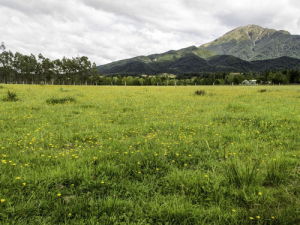Global market settings are firmly in favour of New Zealand farmers. The world economy is enjoying a broad-based recovery, the prices of the key commodities produced in New Zealand are generally high, and global input prices (fertiliser especially) are low.
While the New Zealand dollar has strengthened in the last month or so, it remains around its five-year average, with potential to drift lower through the year.
But 2018 should be a profitable year for most New Zealand producers across an unusually broad base of subsectors. As the second consecutive good year, it looks set to generate a sense of sustained recovery in New Zealand agriculture.
Dairy
Rabobank’s forecast payout for the 2017/18 season stands at NZD 6.30/kgMS. This is slightly below Fonterra’s forecast payout of NZD 6.40/kgMS. This would be the second consecutive farmgate price above NZD 6.00/kgMS, underpinning a second season of profitability.
Seasonal conditions remain unfavourable for New Zealand dairy farmers. Since late 2017, most of the country has become very dry, which has impacted soil moisture levels and pasture production. While some regions have had some much-needed rain since the start of 2018, for many it is not enough. Some regions have been drought declared.
As the new year begins, national milk production is being negatively impacted.
The latest advice is for Fonterra’s milk intake to be down 3% on the previous season at 1,480m kgMS.
Growth in the global exportable surpluses will continue to expand in Q1 2018—meaning ongoing pressure on global prices.
Beef
As rising global beef production puts downward pressure on prices, continued demand growth in New Zealand’s major export markets, in particular the US and China, will be key to holding domestic cattle prices firm and above long-term average returns.
While Rabobank forecasts New Zealand’s cattle exports for the 2017/18 season to be similar to 2016/17 (just under 600,000 tonnes cwt), global beef production is expected to expand for a third consecutive year, primarily driven by production growth in the US (+3% YOY) and Brazil (+5% YOY). This will create headwinds for beef-exporting countries throughout 2018.
Dry conditions throughout the country during November/December resulted in a significant increase in the number of cattle slaughtered late in 2017 (as of 9 December the bull and cow kill were up on the same stage last year—by 29% and 23% respectively).
Recent rainfall should stall the flow of cattle to the processors, easing downward pressure on schedule prices in the short term.
Sheepmeat
Rabobank expects that low levels of global lamb inventory, combined with flat New Zealand production and strong in-market prices will continue to support strong farmgate returns through 2018.
Beef and Lamb NZ estimates that the New Zealand lamb crop is up 1.9% YOY (436,000 head) on the back of a record ewe lambing percentage (127.2%) for spring 2017. Despite this increase, Beef and Lamb NZ is forecasting the 2017-18 export lamb slaughter to be similar to the low levels seen in 2016-17 (19.27m head), anticipating that more replacement lambs will be kept to maintain flock levels. This will help to maintain procurement pressure domestically and ensure that global export supply remains limited.
With a high volume of stock brought forward for processing prior to Christmas, lamb supply through January could be limited, as processors look to fill orders for Easter shipments (which run until the end of January), increasing competition for lambs that are ready for slaughter. However, it is likely there will be some easing of schedule prices through February/March as domestic supply increases.
Wool
Plentiful supply of broad wool has kept crossbred wool prices at eight-year lows through the first half of 2017/18. Although the downward trajectory of prices has steadied, and some signs of positive demand appeared in late 2017, the outlook for 2018 is for persisting subdued market conditions.
While wool production is forecast by Beef and Lamb NZ to lift just 1% YOY, seasonal strong offers will likely continue through the first half and weigh on prices.
At a macro level, the strong global growth outlook should help maintain improved export and pull through demand for wool fibre.
NZ dollar and interest rates
The outlook is for the New Zealand economy to shake off post-election jitters and post similar growth in economic activity in 2018, but with increasing risk of an economic slowdown.
There are still plenty of question marks regarding the outlook for the local pace of inflation. This is the key reason why the general view is that the Reserve Bank (RBNZ) will not raise interest rates for some time.
It was not the best start to the year for New Zealand exporters, with the New Zealand dollar starting the year strong. The US dollar begins the year languishing at its lowest level in three years. The Federal Reserve is widely expected to deliver three interest rate increases in 2018, which would usually support the US dollar.
The general consensus is that the New Zealand dollar will decline slightly by the end of the year. Rabobank retains a bearish outlook for NZD/USD and looks for a move towards 0.65 on a 12- month view.
• Want to keep up-to-date with the latest food & agribusiness insights? Tune into RaboResearch Food & Agribusiness Australia & New Zealand podcast channel. Most Apple devices have the Podcasts app pre-installed—if not, you can find it in the App Store. These are also available on Android devices.





